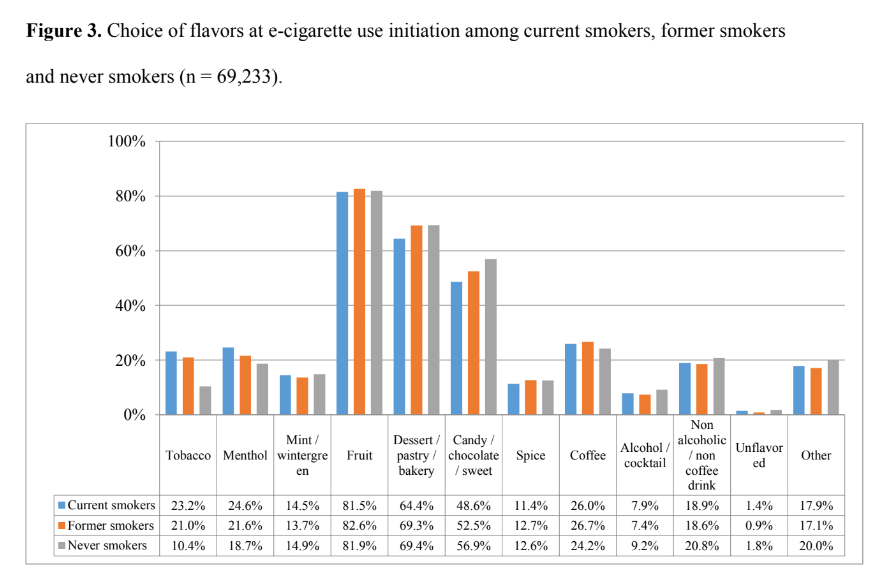On May 6, 2020, the American Journal of Public Health (AJPH) published an article by Brian Erkkila, Patricia Kovacevic, and Derek Yach titled, “Restricting Flavors in ENDS Could Have Repercussions Beyond Youths’ Use.” The authors review recent US Food and Drug Administration (FDA) regulatory guidance on electronic nicotine delivery systems (ENDS), including plans to restrict access to nicotine vaping ‘flavors.’ The new FDA restrictions were driven, in part, by concerns about underage nicotine vaping.
Some US tobacco control advocates and experts claim that ‘flavors’ attract teens, and that restricting ‘flavors’ will reduce under-age nicotine vaping (which is already illegal). For evidence, they point to surveys showing that teens initiate nicotine vaping with ‘flavor,’ and that teens say they like ‘flavors.’ There are serious flaws in that logic.

Unexamined assumptions
Since almost all nicotine vaping liquids are flavored, most teens who vape start out with flavored products. That’s what’s available. Researchers at my alma mater, the University of Michigan, recently surveyed US teens and found that “only 5% of youths mentioned flavors as a driver of use.”
No studies have been conducted showing that a flavor ban will reduce underage vaping. There is, however, evidence such bans will not achieve that goal. In late 2018, the major nicotine vaping company JUUL stopped selling fruit and dessert-flavored vape pods. JUUL sales did not drop. Most teens who continued to “juul” just switched to tobacco, mint, or menthol flavors. Adult customers (the majority of JUUL’s customers) did the same.
In AJPH, Erkkila et al. note, “The [FDA] Guidance’s focus on flavored ENDS fails to address recent CDC data, which indicates that the major drivers of youths’ ENDS use are curiosity and peer influence—not flavors (ref.). There are potentially more effective approaches to tackle youth vaping, such as enhanced marketing and access restrictions and improved enforcement of existing regulations.”
Unintended consequences
As the AJPH article authors note, banning ‘flavors’ might indeed reduce teen vaping as some teens switch to cigarettes (high harm) or to vaping bootleg tetrahydrocannabinol (THC) products (associated with 2019 EVALI lung poisonings). At the same time, restricting access to ‘flavors’ could discourage adult smoking cessation. A study of 20,836 adult frequent e-cigarette users in the United States found that flavors are popular with adults and important for vaping initiation and continued use.
Almost all adult ex-smokers who switch to nicotine vaping prefer fruit, dessert, or candy flavors that do not remind them of cigarettes (see graph below). One study of adult vapers found that preferences for tobacco, menthol, and mint flavors tends to decrease over time, while preferences for candy and sweet flavors increases. Pharmaceutical companies clearly understand adult preferences; nicotine gum comes in a variety of fruit and candy flavors.

Survey conducted in 2018 involving 69,233 US adult e-cigarette users: Data show “the choice of flavors at e-cigarette use initiation according to the smoking status at the time of survey participation. For all groups, fruit flavors were the most popular, followed by dessert/pastry/bakery and candy/chocolate/sweet flavors.”
Submitted to FDA docket.Source: https://www.dropbox.com/s/b8uwoxay6i2fzb2/Docket%20No.%20FDA-2017-N-6565_FARSALINOS.pdf?dl=0
Research shows that smokers are almost two times more likely to quit if they use ‘flavored’ rather than tobacco-flavored nicotine vaping products. Surveys of adult vapers indicate that between 12% and 17% would relapse to smoking if ‘flavors’ are banned. By 2018, at least 3 million US smokers had quit smoking cigarettes completely by switching to nicotine vaping. So, banning all but tobacco flavor could increase the number of US smokers by 300,000 to 510,000 almost overnight.
Takeaway
As one of my old university mentors might have said with a wry smile, it should be “obvious to the most casual observer” that policies restricting access to ‘flavors’ are unlikely to achieve their stated goals, and highly likely to have harmful unintended consequences. A ‘flavor’ ban may actually increase teen harms. No one wants under-age persons to vape. But even if a ‘flavor’ ban does marginally reduce that illegal behavior we need to ask: How many adult lives are we willing to put at risk to achieve that goal?
© 2023 Foundation for a Smoke-Free World. All rights reserved.